Building a deck doesn’t have to drain your savings account. Smart planning and clever design choices can help you create an outdoor space that looks expensive but costs much less. These practical tips will show you how to build a beautiful deck while keeping your budget intact.
Start With a Realistic Budget Plan
Setting a clear budget is your first step to deck success. Most homeowners spend between $2,250 to $30,000 on deck projects, with pressure-treated wood starting around $3 per square foot and composite materials ranging from $21-30 per square foot including all materials.
Use this simple formula to calculate your deck costs:
Materials cost = Square footage × Cost per square foot
Total project cost = Materials + Labor + Permits + Extras
Money-Saving Budget Tips
Create a detailed spreadsheet listing every item you need. Include:
Foundation materials Framing lumber Decking boards Fasteners and hardware Railings and balusters Stain or sealant Tools (if needed)
Add 10-15% extra for unexpected costs. This buffer prevents budget overruns when you discover issues during construction.
Choose the Most Affordable Decking Materials
Your material choice makes the biggest impact on your final cost. Here’s what you need to know about budget-friendly options:
Pressure-Treated Wood: The Budget Champion
Pressure-treated wood remains the most affordable option at $3-6 per square foot. This treated lumber resists rot and insects, making it perfect for budget builds.
Pros:
- Lowest upfront cost
- Easy to work with
- Available everywhere
- Can be stained any color
Cons:
- Requires annual maintenance
- May warp or crack over time
- Shorter lifespan than alternatives
Also Read: 25 Stunning Pergola Ideas That Transform Any Backyard 2025
Smart Shopping for Materials
Buy materials during off-season months (late fall through early spring) for better prices. Many suppliers offer discounts when demand drops.
Shop at contractor lumber yards instead of big box stores. You’ll find:
- Higher quality boards
- Longer lengths (fewer seams)
- Better selection
- Competitive pricing
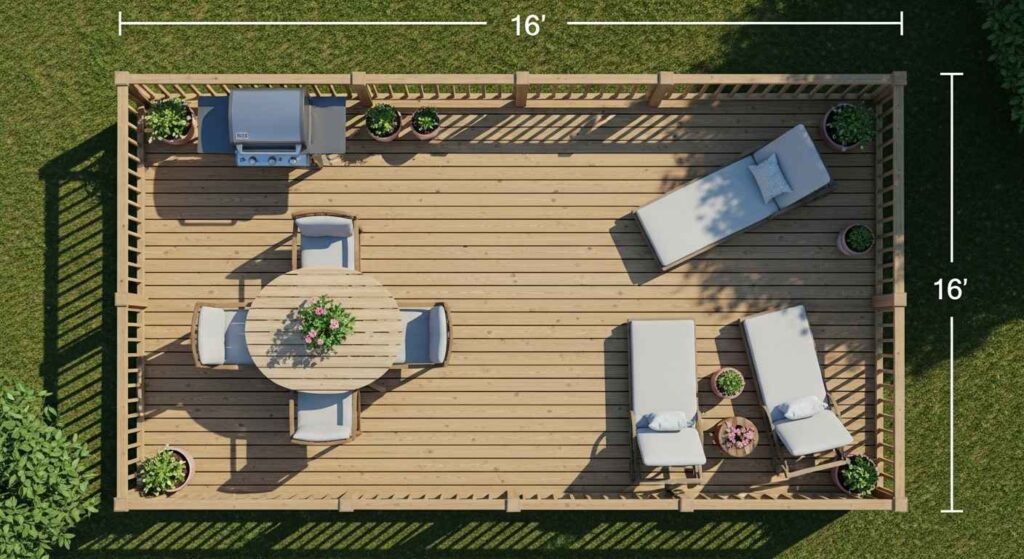
Design Smart to Save Big
Simple design changes can cut thousands from your project cost. Follow these design principles:
Keep Your Shape Simple
Complex shapes require more materials and increased labor costs. Stick to rectangles and squares for maximum savings.
Avoid these expensive features:
- Curved edges
- Multiple levels
- Octagon shapes
- Built-in planters
Instead, add interest with:
- Diagonal decking patterns
- Contrasting border boards
- Strategic furniture placement
- Potted plants for greenery
Size Matters for Your Budget
Don’t make your deck footprint too large. Keep your design tight, maintaining a functional area just big enough to address your needs.
A 12×16 foot deck (192 square feet) provides enough space for:
- Small dining table with 4 chairs
- A grill
- Two lounge chairs
- Movement space
This size costs significantly less than a 20×20 foot deck while still being functional.
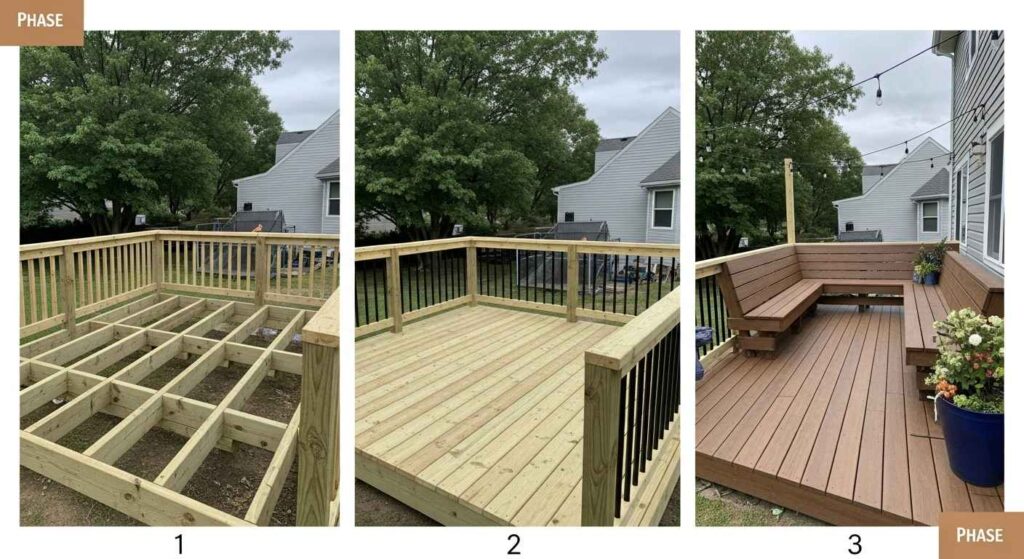
Build Low to Save More
Deck height directly affects your costs. If you can keep your deck low to the surrounding ground, you can potentially do away with the need for steps, stairs, and even handrails.
Low-Level Deck Benefits
Building 30 inches or less above ground eliminates:
- Stair construction costs
- Handrail requirements (in most areas)
- Complex foundation work
- Additional lumber needs
A ground-level deck can cost 30-50% less than elevated designs.
Foundation Cost Savings
For low decks, consider these budget-friendly foundation options:
- Concrete deck blocks ($8-12 each)
- Gravel pads with pressure-treated posts
- Helical piers for problem soils
Skip expensive poured concrete footings when possible.
DIY vs. Professional Installation
Labor typically accounts for about two-thirds of the total cost. This means a $9,000 deck project includes about $6,000 in labor costs.
DIY Money-Saving Potential
Building your own deck can save $3,000-6,000 on a typical project. You’ll need:
- Basic carpentry skills
- Essential tools
- 2-3 weekends of time
- A helper for heavy lifting
When to Hire Professionals
Call the pros for:
- Electrical work (lighting, outlets)
- Complex structural issues
- Permit applications
- Heights above 8 feet
Phase Your Project to Spread Costs
Deciding to tackle your project in phases means you can split the costs over time. This approach lets you build what you can afford now and add features later.
Phase 1: Basic Structure
- Foundation and framing
- Basic decking boards
- Simple stairs (if needed)
Phase 2: Railings and Safety
- Post and rail system
- Balusters
- Gate installation
Phase 3: Finishing Touches
- Built-in seating
- Lighting systems
- Storage solutions
- Decorative elements
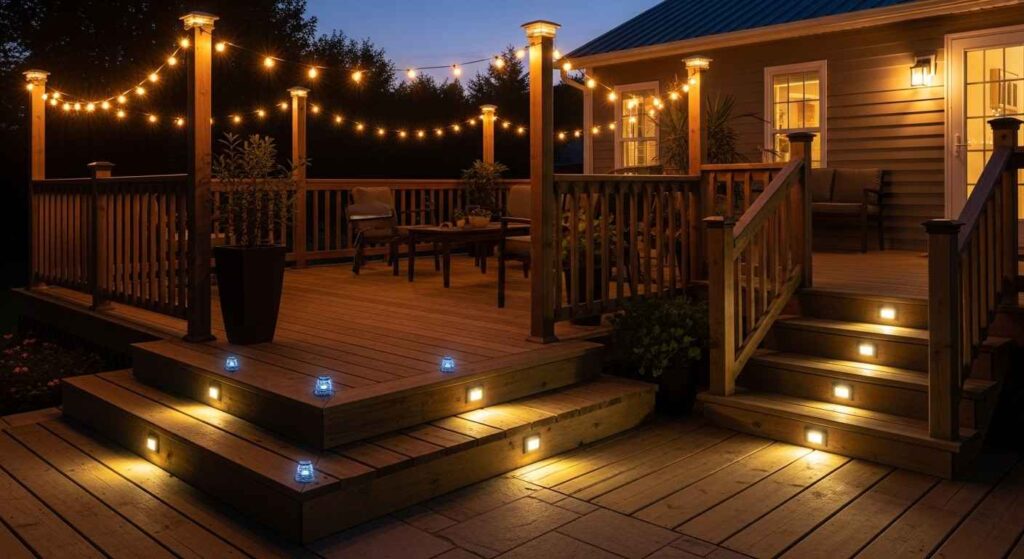
Minimize Material Waste
Design your deck with as little waste as possible. After all, you will have to pay for all the waste material that ends up in the trash.
Waste-Reducing Strategies
Plan your deck dimensions around standard lumber lengths:
- 8-foot boards
- 12-foot boards
- 16-foot boards
- 20-foot boards
Use cutoff pieces for:
- Blocking between joists
- Deck board ends
- Small repair projects
- Fire starter wood
Smart Layout Planning
Draw your deck to scale before buying materials. This prevents:
- Ordering too much lumber
- Making costly measurement mistakes
- Needing multiple material trips
- Wasting money on unusable pieces
Money-Saving Railing Solutions
Railings can cost $15-50 per linear foot depending on style. Save money with these approaches:
Budget Railing Options
Pressure-treated wood balusters: $8-12 per linear foot
- Simple and functional
- Easy to install
- Matches deck boards
- Can be dressed up with caps
Cable railings: $25-35 per linear foot
- Modern appearance
- Minimal visual obstruction
- Durable stainless steel
- Less maintenance than wood
Avoid expensive options like:
- Wrought iron ($45-65 per foot)
- Composite balusters ($35-50 per foot)
- Custom metalwork ($60-100+ per foot)
Also Read: DIY Outdoor Movie Night Setup Under $300 – Complete Guide
Lighting on a Shoestring Budget
Good lighting extends your deck’s usability without breaking your budget.
Affordable Lighting Ideas
Solar deck lights: $15-30 each
- No electrical work needed
- Easy installation
- Automatic on/off
- Zero operating costs
String lights: $20-50 for 50 feet
- Creates ambiance
- Hangs from existing structures
- Multiple style options
- Low energy use
LED step lights: $25-40 each
- Improves safety
- Long-lasting bulbs
- Low voltage options available
- Professional appearance
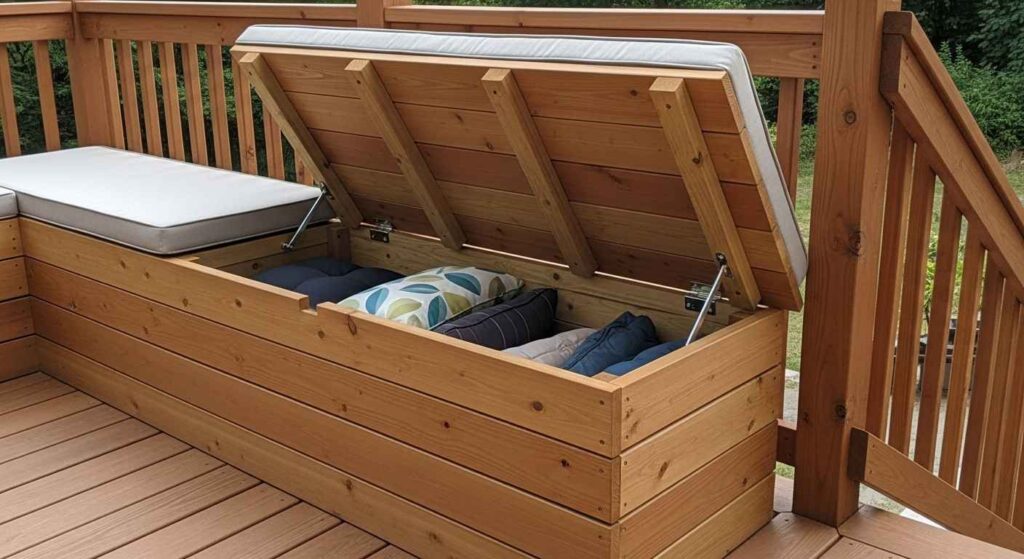
Maintenance Planning Saves Long-Term Costs
You can expect to pay anywhere between $400 annually to maintain a typical wood deck, compared to a composite deck of the same size that would likely cost less than $10 to clean.
Annual Wood Deck Maintenance Costs
- Deck cleaner: $25-40
- Stain or sealant: $75-125
- Brushes and rollers: $20-30
- Repair materials: $50-100
- Total: $170-295 in materials plus your time
Maintenance-Saving Tips
Choose the right stain type:
- Solid stain: Lasts 4-6 years, covers imperfections
- Semi-transparent: Lasts 2-4 years, shows wood grain
- Clear sealant: Lasts 1-2 years, natural appearance
Apply stain during optimal conditions:
- Temperature between 50-80°F
- No rain expected for 24 hours
- Low humidity
- Avoid direct sunlight
Budget-Friendly Deck Accessories
Add functionality without overspending on these practical additions:
Storage Solutions
Deck boxes: $75-200
- Weather-resistant storage
- Doubles as seating
- Keeps cushions dry
- Multiple size options
Under-deck storage: DIY for $50-150
- Use lattice panels
- Add shelving inside
- Store lawn equipment
- Maximize space usage
Seating Options
DIY built-in benches: $100-250
- Use deck framing lumber
- Add storage underneath
- Create custom lengths
- Permanent solution
Outdoor furniture sets: $200-800
- Shop end-of-season sales
- Consider used options
- Mix and match pieces
- Weather-resistant materials
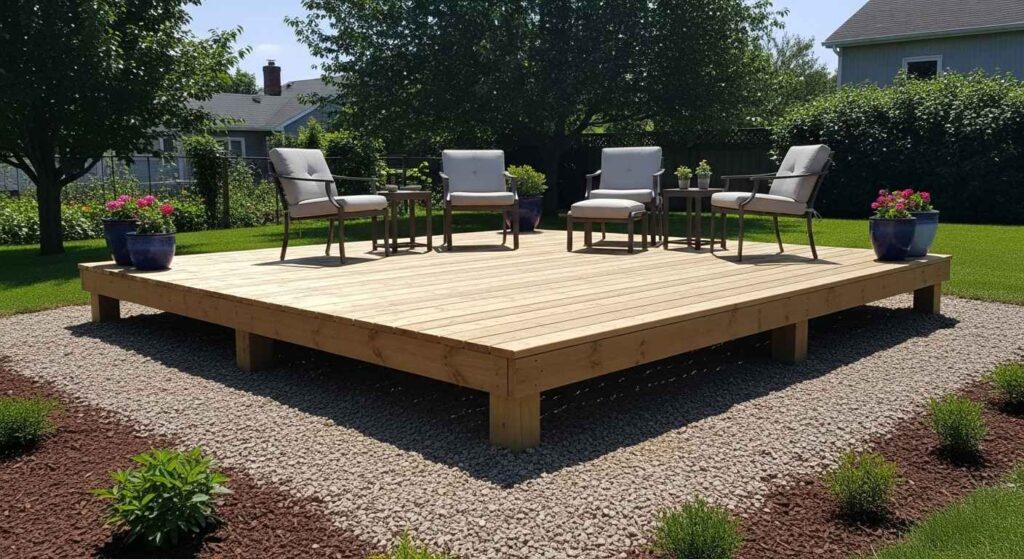
Seasonal Planning for Maximum Savings
Timing your deck project affects material and labor costs significantly.
Best Times to Buy Materials
Late fall/winter:
- Lumber prices typically lowest
- Suppliers clear inventory
- Less competition from contractors
- Time to plan and prepare
Early spring:
- Pre-season sales
- New inventory arrives
- Weather improves for building
- Contractor availability increases
Avoid Peak Season Pricing
Summer months bring:
- Highest material costs
- Limited contractor availability
- Rushed project timelines
- Premium pricing for everything
Plan your project for shoulder seasons to maximize savings.
Alternative Budget Deck Ideas
Consider these creative alternatives to traditional deck construction:
Patio Pavers with Deck Sections
Combine concrete pavers ($2-5 per square foot) with small deck areas for seating or dining. This hybrid approach costs less than full deck construction.
Floating Deck Platforms
Build separate deck platforms that don’t attach to your house:
- No permit required (usually)
- Simpler construction
- Can be moved if needed
- Lower material costs
Pergola-Style Cover Addition
Add partial coverage with a simple pergola:
- Use standard lumber sizes
- Simple post and beam construction
- Add shade cloth or vines
- Creates defined outdoor room
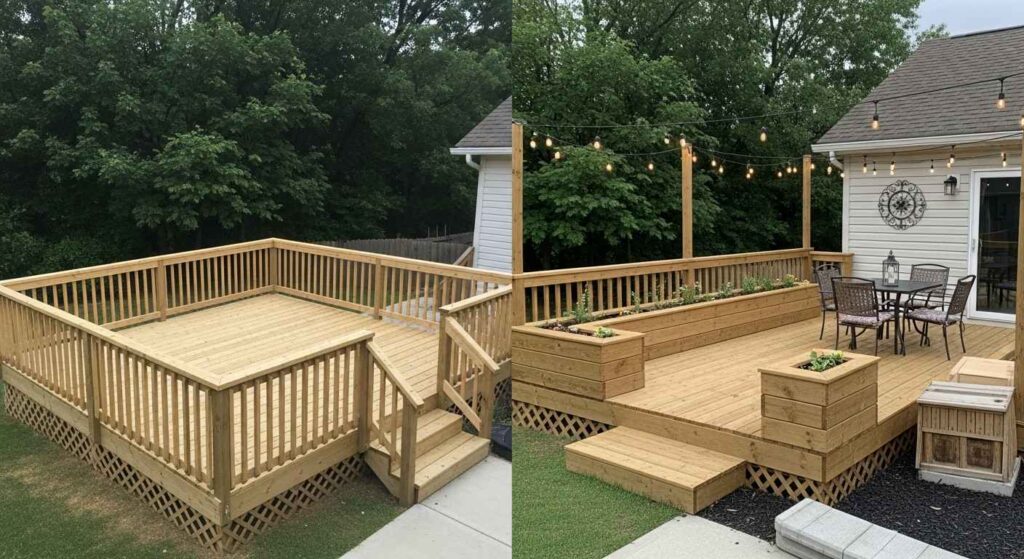
Smart Shopping Strategies
Buy in Bulk When Possible
Purchase materials in bulk for better pricing:
- Deck screws by the pound
- Lumber in full units
- Stain in larger containers
- Hardware in bulk packages
Compare Total Project Costs
Don’t just compare board prices. Factor in:
- Fastener compatibility
- Maintenance requirements
- Longevity expectations
- Warranty coverage
Negotiate with Suppliers
Many lumber yards will negotiate on large orders:
- Ask about contractor discounts
- Request price matching
- Bundle purchases for better rates
- Consider cash payment discounts
Final Cost-Cutting Tips
Use Standard Dimensions
Design around standard lumber sizes to avoid special orders and waste:
- 12, 16, or 20-foot deck boards
- 8-foot post heights
- Standard joist spacings (16″ or 24″)
- Common beam sizes
Reuse Existing Materials
Salvage materials from other projects:
- Old deck boards for blocking
- Concrete blocks for footings
- Hardware from renovations
- Tools from friends or neighbors
Skip Unnecessary Features Initially
Build the basic deck first, then add features as budget allows:
- Built-in planters
- Elaborate lighting systems
- Custom railings
- Decorative elements
Conclusion
Building a budget-friendly deck requires smart planning, material selection, and design choices. Focus on creating a functional outdoor space that meets your immediate needs while leaving room for future improvements.
Remember these key money-saving principles:
- Choose affordable materials that fit your maintenance preferences
- Keep designs simple and low to the ground
- Phase your project to spread costs over time
- Do what you can yourself while leaving complex work to professionals
- Plan for seasonal pricing and material availability
Your deck should enhance your outdoor living experience without creating financial stress. With careful planning and these proven strategies, you can build a beautiful deck that fits your budget and provides years of enjoyment.
For more outdoor living inspiration, check out our affordable backyard makeover ideas and small patio design tips to complete your outdoor space transformation.
Also Read: 15 Easy DIY Backyard Water Features You Can Build Fast
